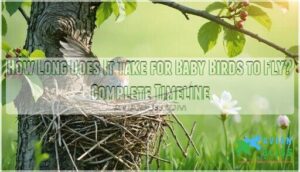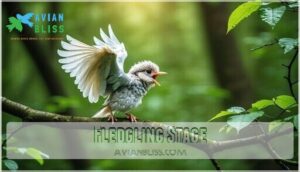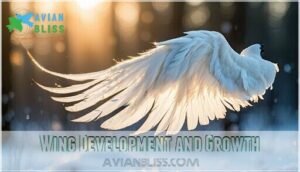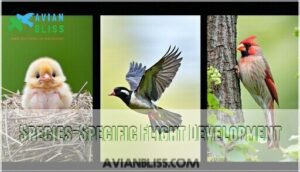This site is supported by our readers. We may earn a commission, at no cost to you, if you purchase through links.

Think of it like learning to ride a bike—some kids master it in a weekend, while others need more practice time.
Smaller songbirds like robins often fledge around 13-14 days, while larger species such as hawks can take up to three weeks or more.
The timing depends on wing development, muscle strength, and species-specific needs.
Weather conditions and food availability also play key roles in determining when these little aviators are ready for takeoff.
Each species follows its own unique flight school curriculum.
Table Of Contents
- Key Takeaways
- Baby Bird Development Stages
- Fledging Age and Preparation
- Wing Development and Growth
- Learning to Fly Timeline
- Environmental Factors and Flight
- Species-Specific Flight Development
- Hummingbird Flight Development
- Large Bird Flight Development
- Full Flight Capabilities and Independence
- Frequently Asked Questions (FAQs)
- How long does it take a baby bird to fly out of its nest?
- What to do if a baby bird is on the ground?
- How long are baby birds in the nest?
- Can baby birds fly as soon as they leave the nest?
- When do baby birds fledge?
- How long does it take a baby bird to learn to fly?
- How long does it take a baby bird to develop wings?
- How long does it take a bird to fly after hatching?
- What do baby birds eat before they fly?
- How do weather conditions affect flight readiness?
- Conclusion
Key Takeaways
- You’ll see most baby birds take their first flight between 10-21 days after hatching, though this varies dramatically by species – smaller songbirds like robins fledge around 13-14 days while larger birds like hawks need up to three weeks or more.
- You can’t expect baby birds to fly immediately after leaving the nest since they’re called fledglings and need several additional days to weeks practicing wing movements, building flight muscles, and mastering landing techniques before achieving true flight independence.
- You’ll notice that environmental factors like weather conditions, food availability, and safe landing spots can either speed up or delay a young bird’s flight development by several days or weeks – cold weather slows muscle development while mild, stable conditions help birds reach flight readiness faster.
- You should understand that larger bird species require significantly more time to develop flight capabilities, with eagles taking 10-12 weeks and California condors needing over 12 months of parental care before achieving independence, compared to tiny hummingbirds that master flight in just 18-22 days.
Baby Bird Development Stages
When you’re watching baby birds in your backyard, you’ll notice they progress through three distinct development stages before they can fly independently.
These stages include the helpless nestling phase when chicks are blind and featherless, the active fledgling stage where they develop flight feathers and practice wing movements.
Nestling Stage
Understanding the nestling stage means recognizing when baby birds are completely helpless. During this critical early development phase, you’ll observe tiny, blind, and featherless chicks depending entirely on parental feeding for survival. The nest environment provides essential warmth and protection while feather emergence gradually begins.
- Monitor nestling care without disturbing the nest
- Watch for initial feather emergence signs
- Observe consistent parental feeding patterns
- Note increased activity before nest departure
- Track progress toward fledgling timeline milestones
This stage determines successful bird fledging age and eventual fledging.
Fledgling Stage
After nestlings grow their initial feathers, they enter the fledgling stage where real preparation begins.
Fledgling Development accelerates as Flight Feathers reach full capacity and Muscle Growth builds essential strength. These fledglings can’t fly yet, but they’re getting close.
Coordination Systems mature while Energy Reserves build through increased feeding. The fledgling timeline varies by species, but most spend 1-2 weeks in this stage.
You’ll see them hopping and wing-flapping vigorously, strengthening flight muscles for their upcoming aerial debut. Like nestlings, fledglings require high protein nourishment to support their rapid growth.
safe spots
Learning to Fly
Once fledglings master basic coordination, they begin testing their wings through flight challenges that’ll make your heart skip a beat.
Watching baby birds take their first wobbly flight attempts is like witnessing pure courage in action.
The fledging process combines instinct vs. learning as young birds develop flight techniques under parental influence.
- Muscle coordination improves through repeated wing-flapping exercises before attempting bird first flight
- Flight development occurs gradually, with short hops between branches building confidence
- Birds learning fly often experience crash landings during early bird flight development attempts
- Parental influence guides timing and technique as adults demonstrate proper takeoff methods
Fledging Age and Preparation
When you’re watching baby birds prepare for their first flight, you’ll notice they reach fledging readiness at dramatically different ages depending on their species.
While tiny hummingbirds like Ruby-throated and Anna’s varieties can achieve flight in just 18-22 days, their preparation involves intense muscle development that reaches 25% of their total body weight before they’re ready to leave the nest.
Ruby Throated Hummingbird
Ruby-throated hummingbirds follow a precise bird flight timeline during their fledging process.
These remarkable hummingbirds spend 18-22 days in walnut-sized nests before taking flight. Bird development stages include wing muscle strengthening and hovering flight practice.
Mother birds demonstrate feeding techniques at nectar sources, preparing youngsters for their pollination role.
Within weeks of mastering flight, these tiny aviators begin preparing for hummingbird migration – an 800-kilometer journey across the Gulf of Mexico. Their bird flight development happens remarkably fast for such demanding travels.
These hummingbirds are classified within the Trochilidae hummingbird family.
Anna’s Hummingbird
Most Anna’s hummingbirds achieve their flight milestones between 18-22 days after hatching.
You’ll find these remarkable tiny aviators developing flight capabilities through precise stages during their incubation period and fledging process.
Their flight readiness is influenced by several factors.
Their flight development follows these key patterns:
- Wing strength builds through repeated flapping exercises
- Nest building by females creates secure launch platforms
- Annas Diet of nectar and insects fuels rapid growth
- Mating Rituals and parental care support fledging success
- Urban Adaptation helps them thrive in city environments
Unlike Migration Patterns of other species, these hummingbirds remain year-round residents, perfecting their aerial mastery.
Wing Development and Growth
You’ll notice that a baby bird’s wings undergo remarkable changes during the first few weeks of life, transforming from tiny, featherless appendages into powerful flight instruments.
The development process involves both bone strengthening and feather growth, with flight muscles reaching 15-25% of the bird’s total body weight before they’re ready to take their first flight, which is a result of the bird’s total body weight and muscle growth.
Wing Bones and Feathers
Development unfolds like nature’s blueprint as baby bird wings transform from fragile stubs into powerful flight instruments.
You’ll notice feather composition changes dramatically—downy fluff gives way to structured primaries with proper airfoil design.
Meanwhile, bone density increases while skeletal development strengthens the wing framework.
Flight muscles attach to these growing bones, and wing shape becomes more aerodynamic.
This intricate feather growth process determines when your backyard visitors will finally spread their wings and take that first leap into freedom.
Factors Influencing Wing Development
Several key elements shape how quickly your backyard visitors develop flight-ready wings.
Genetics determine the baseline timeline, while a protein-rich diet fuels vital muscle development and feather quality.
Environmental factors like temperature and safety directly impact bone density and overall wing development.
When nutrition’s impact combines with consistent parental care, young birds build the strength needed for their maiden voyage skyward.
Learning to Fly Timeline
You’ll witness baby birds progress through distinct flight milestones, from their first wobbly wing flaps to confident short-distance flights over several weeks.
Most species follow a predictable pattern that starts with vigorous flapping exercises in the nest and advances through clumsy practice sessions before achieving full mastery.
Short Flights and Practice Sessions
Once wing development reaches adequate strength, young birds start their Initial Flight Duration attempts lasting just seconds.
These short flights represent serious flight practice that builds coordination and confidence.
You’ll observe three key behaviors:
- Flapping Frequency increases dramatically during wing exercise sessions
- Landing Techniques improve through repeated attempts and Mid-Air Corrections
- Parental Encouragement through calls motivates continued flight skills and muscle development progress
Crash Landings and Stumbles
You’ll witness plenty of tumbles as young birds master their landing skills. These flight challenges teach essential lessons about avoiding obstacles and managing landing impact.
Parental assistance remains essential during this wobbly phase, as adults demonstrate proper techniques while staying alert to injury risk.
| Common Mistakes | Flight Risks | Learning from Falls |
|---|---|---|
| Misjudging distance | Balance loss on branches | Improved depth perception |
| Too-fast approaches | Wing clipping on objects | Better speed control |
| Poor timing | Ground impacts | Enhanced coordination |
| Weak grip strength | Predator exposure | Stronger landing reflexes |
Practice makes perfect in flight school.
Environmental Factors and Flight
You’ll find that weather conditions, food availability, and habitat safety substantially impact when baby birds take their first flights.
Environmental factors like temperature, wind patterns, and the presence of safe landing spots can either speed up or delay a young bird’s flight development by several days or even weeks.
Safe Landing Spots
Young fledglings need soft surfaces like thick grass or low shrubs for their first landing techniques.
Parental guidance steers them toward branches that won’t break under clumsy crashes. Dense foliage provides predator avoidance while they master landing skills.
A safe environment with multiple perching options reduces flight risks and predation risk, giving these wobbly fliers the injury prevention they desperately need.
You can find essential fledgling supplies to aid in their development.
Wind Currents and Weather Conditions
Weather conditions dramatically shape when baby birds take their maiden flights. Wind impact and temperature influence create the perfect storm—or calm—for fledgling success.
Here’s how environmental factors affect flight timing:
- Gentle breezes provide helpful lift assistance during practice sessions
- Weather effects like storms delay attempts, keeping chicks grounded for safety
- Warmer climates accelerate development while colder regions slow progress
Climate change can also lead to migration route shifts, impacting fledgling survival rates.
Species-Specific Flight Development
You’ll notice dramatic differences when you compare flight development across bird species, as each follows its own unique timeline based on size, habitat, and survival needs.
While songbirds like Baltimore Orioles and Northern Cardinals typically fledge within two to three weeks, larger species such as Canada Geese and Pileated Woodpeckers require substantially more time to develop the muscle strength and coordination necessary for successful flight, which is influenced by their specific survival needs.
Baltimore Oriole
Baltimore Orioles showcase fascinating bird flight development timeline patterns. These vibrant bird species spend 12-14 days in their hanging basket nests before fledging. You’ll notice their Oriole Plumage differs from adults during early flight stages.
| Development Stage | Timeline |
|---|---|
| Nestling Period | 12-14 days |
| First Flight Attempts | 2-3 weeks after hatching |
| Flight Mastery | 4-5 weeks total |
Baby birds flying skills improve rapidly through practice. Their Oriole Diet shifts from parent-fed insects to independent foraging. Oriole Migration preparation begins once flight capabilities develop, supporting Oriole Conservation efforts through successful reproduction.
Northern Cardinal
Unlike Baltimore Orioles, Northern Cardinals showcase distinctive flight development patterns.
Cardinal fledging age occurs between 9-13 days, with parental care extending weeks beyond initial flights.
You’ll notice Cardinal flight style develops through awkward short hops before achieving smooth navigation.
Cardinal diet impact substantially influences growth stages, while Cardinal habitat influence affects fledging timing in dense shrubs.
- Tiny hearts beating 1,000 times per minute during first flight attempts
- Desperate chirps calling for parental guidance during crash landings
- Vulnerable moments learning survival skills in dangerous territory
- Parents’ unwavering dedication protecting their helpless offspring
Cardinal nutrition accelerates flight development remarkably.
Canada Geese
Canada Geese showcase remarkable gosling development through intensive parental investment.
You’ll observe these waterfowl achieving flight development around 10 weeks, with parental care guiding migration preparation.
Their flight mechanics depend heavily on habitat influence – open water provides ideal practice space.
Unlike songbirds, geese fledging involves family groups learning flight milestones together, creating strong bird life cycle bonds before autumn journeys.
Pileated Woodpecker
Pileated Woodpecker fledglings face unique challenges in their flight development journey.
These magnificent woodpeckers leave the nest at 26-28 days old, but they can’t fly well immediately.
Parental care extends through September, with parents coaxing young birds to practice, which involves gradual skill-building as habitat impact and flight mechanics become essential for survival.
These birds are non-migratory, remaining in year-round territories, and receive parental care that supports their development.
Hummingbird Flight Development
Hummingbird babies face a unique challenge when mastering flight.
You’ll find these tiny creatures develop differently than other bird species flight patterns.
Their baby bird growth focuses on building specialized muscles for hovering techniques within just 18-22 days after hatching.
Unlike ground-dwelling birds, young hummingbirds must perfect backward and sideways movement immediately.
Their tiny wings beat up to 80 times per second, requiring exceptional flight metabolism that burns enormous energy.
During early flight development, they’ll practice short bursts between flowers, gradually building stamina for nectar flight journeys.
Migration patterns don’t influence fledglings initially—they focus on mastering local hovering techniques first.
You’ll notice their flight milestones include learning to hover motionless while feeding, a skill that takes weeks to perfect.
Their bird flight development emphasizes precision over distance, making them aerial acrobats by the time they’re ready for independence.
Large Bird Flight Development
When you’re watching large birds like eagles or hawks, you’ll notice their babies take substantially longer to develop flight skills than smaller species.
These powerful raptors require 8 to 12 weeks to build the massive flight muscles and coordination needed to carry their impressive wingspans through the sky.
Owls and Hawks
Owls and hawks represent fascinating examples of raptor development.
These birds of prey showcase remarkable nocturnal flight abilities and hawk hunting precision.
Owlets typically achieve owl flight capabilities between 4-5 weeks, while young hawks master their aerial skills around the same timeframe.
Both species demonstrate incredible flight development, with raptors building essential wing strength through persistent practice sessions before achieving independence.
Eagles and California Condor
Looking at nature’s giants, you’ll find eagles and California condors represent the extreme end of flight development timelines.
Eagles fledge around 10-12 weeks, requiring extensive parental care during their flight learning process. California condors take dramatically longer, with chicks depending on parents for over 12 months before achieving independence.
These flight milestones reflect significant size comparison differences and unique habitat needs. Eagle hunting skills develop gradually, while condor conservation efforts monitor every flight differences milestone.
Bald eagle populations have recovered in California due to increased protections. Both species showcase nature’s patient approach to developing powerful flight capabilities.
Full Flight Capabilities and Independence
Once young birds master sustained flight, they’re ready to spread their wings in the truest sense.
You’ll notice these independent flyers confidently traversing air currents, executing sharp turns, and landing with precision. Their flight abilities now include independent hunting skills, allowing them to catch insects mid-air or spot food sources from considerable heights.
Bird migration becomes possible as their flight independence develops fully. These newly capable aviators can now handle predator evasion through swift aerial maneuvers and establish their own territory away from parental protection.
Self-sufficiency kicks in around 6-12 weeks for most species, though larger birds may take several months to achieve bird flight full capability.
Independent flying means they’ll venture further from home, relying on instinct and learned behaviors to survive. This marks their complete transformation from helpless nestlings to fully autonomous birds ready to face the world.
Frequently Asked Questions (FAQs)
How long does it take a baby bird to fly out of its nest?
Your feathered friend’s departure from home varies dramatically by species.
Most songbirds take their maiden voyage within 12-18 days, while larger birds need 4-12 weeks to spread their wings and embrace independence.
What to do if a baby bird is on the ground?
First, observe from a distance to determine if it’s truly abandoned.
Most ground birds are fledglings learning to fly, with parents nearby.
Only intervene if injured, cold, or clearly orphaned—contact local wildlife rehabilitators immediately.
How long are baby birds in the nest?
Ever wonder when those tiny chirpers will finally leave home?
Baby birds typically stay in their nest for 10-30 days, depending on the species.
Smaller songbirds fledge around two weeks, while larger birds need several more weeks to fledge.
Can baby birds fly as soon as they leave the nest?
No, baby birds can’t fly immediately after leaving the nest.
They’re called fledglings and need several days to weeks developing flight muscles, practicing wing movements, and learning landing techniques.
Before achieving true flight mastery, they must practice and develop these skills.
They must develop these skills before achieving true flight mastery.
When do baby birds fledge?
Unlike newborn mammals who can’t walk, most baby birds fledge remarkably early – typically between 10-20 days after hatching.
You’ll see sparrows leave in 12-18 days, while larger species need longer development time.
How long does it take a baby bird to learn to fly?
Most baby birds need 2-4 weeks to master flying after they’ve fledged from their nest.
You’ll see them practicing wing flaps, making short hops, and gradually building the muscle strength needed for sustained flight.
How long does it take a baby bird to develop wings?
Wing development in baby birds happens remarkably fast.
You’ll see their wings forming within days of hatching, with flight feathers growing to full capacity in just two to three weeks depending on the species.
How long does it take a bird to fly after hatching?
Like tiny athletes training for their first marathon, you’ll see most baby birds take their maiden flight between 10-20 days after hatching.
Though larger species need several weeks to develop proper wing strength.
What do baby birds eat before they fly?
You’ll find that nestlings depend entirely on their parents for food.
They are receiving regurgitated insects, worms, seeds, and partially digested meals delivered directly to their beaks every few minutes throughout daylight hours.
How do weather conditions affect flight readiness?
Extreme temperatures can delay fledging by 30-50%.
You’ll notice cold weather slows muscle development and feather growth, while heat stress reduces feeding activity.
Mild, stable conditions help baby birds reach flight readiness faster.
Conclusion
While every species follows its own timeline, you shouldn’t worry if baby birds seem to take forever learning flight basics.
Understanding how long it takes for baby birds to fly helps you appreciate nature’s careful process.
From 10-day hummingbirds to month-long eagles, each bird develops at its perfect pace.
You’ll witness remarkable transformations as nestlings become confident flyers through practice, patience, and instinct. Trust the process—these feathered athletes know exactly when they’re ready for their aerial debut.
- https://globalbirdinginitiative.org/bird-species/ruby-throated-hummingbird/
- https://www.allaboutbirds.org/guide/Ruby-throated_Hummingbird/overview
- https://www.simplybirding.com/birds/ruby-throated-hummingbird-archilochus-colubris/
- https://birdfact.com/birds/ruby-throated-hummingbird
- https://myfwc.com/media/19784/bba_rthu.pdf















